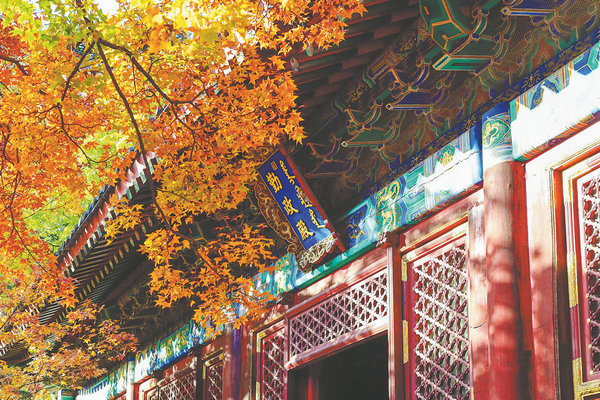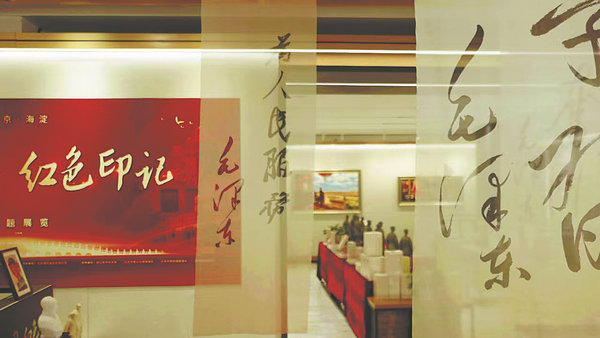
An autumn view of the Fragrant Hills Park in Beijing. [Photo provided to China Daily]
The "Three Mountains and Five Gardens" represent the rich cultural and historical heritage of Beijing. Primarily serving as leisure retreats where the imperial family could relax and entertain, they are now treasured as sites of natural beauty as well as repositories of the nation's historical and cultural heritage.
The Three Mountains are the Fragrant Hills, Jade Spring Hill and Longevity Hill. The Five Gardens are Jingming Garden, Jingyi Garden, Qingyi Garden (The Summer Palace), Changchun Garden and Yuanmingyuan (The Old Summer Palace).
Many important cultural items that were housed in the Three Mountains and Five Gardens were lost during the ravaging of the sites by Western colonialist forces. But recently, 69 important long-lost cultural relics have been recreated in digital form and are now being presented to the public.
This is a phased achievement of the "Three Mountains and Five Gardens Dispersed Cultural Relics Three-dimensional Database Construction Project", led by Wu Xiaomin, the director of the Yuanmingyuan Research Center at the Central Academy of Fine Arts.
The completion of these 69 digital cultural relic models is the result of collaborative efforts involving many volunteers and compatriots both at home and abroad.
"We reached out to scholars and artists studying in France, as well as overseas students, to help us gather information about the dispersed cultural relics," Wu says.
The project has created a digital museum that provides a comprehensive and systematic exhibition of dispersed cultural relics in seven categories. Each artifact is accompanied by a corresponding mini-program. Leveraging technologies such as virtual reality, the exhibition hall offers visitors a unique experience of virtual roaming and close-up appreciation of the items.
"For accessible artifacts, we employ physical scanning and measurements for restoration. For items that cannot be surveyed on-site, we manually create models based on extant photos, striving to authentically reproduce details such as texture and material," Wu says. "The results have been very successful."
 An exhibition titled "Red Memories of Three Mountains and Five Gardens" is held at Dayou Library in Beijing from Jan 3 to 17. [Photo by PENG JIACHANG/FOR CHINA DAILY]
An exhibition titled "Red Memories of Three Mountains and Five Gardens" is held at Dayou Library in Beijing from Jan 3 to 17. [Photo by PENG JIACHANG/FOR CHINA DAILY]
On top of restoring artifacts, digital technology enhances the visitor experience. Take for example the "Forty Scenes of Yuanmingyuan". Due to its two-dimensional nature, the flat presentation of scanned images lacked appeal. Therefore Wu's team leveraging their expertise in ancient architecture, recreated the three-dimensional landscapes depicted in the two-dimensional paintings, providing viewers with a more enthralling immersive experience.
To reach a bigger audience, the digital museum team is also organizing offline touring exhibitions.
Database construction is not the endpoint. Cao Jinsong, the director of the Haidian District Cultural Development Promotion Center, expressed his hope that this database, initially funded by the government, can be utilized by more cultural and creative enterprises to generate cultural products.
Regarding the development of cultural and creative products, Wu believes that it is essential to infuse artistic inspiration into the artifacts.
"We are no longer adhering to traditional presentation methods. Instead, we are blending the form and meaning of cultural relics into contemporary lifestyles and fashion sensibilities, breathing new vitality into the dispersed relics,"Wu says.
For instance, after its digital recreation, a bronze phoenix weather vane that is still missing to this day, is being transformed into "Phoenix Xiaoyuan", a digital avatar that will act as a virtual tour guide for visitors.
Digital methods have enriched the ways traditional culture is being encountered and appreciated.
"Cultural self-confidence is premised on cultural awareness. People need to understand the cultural treasures of their own nation. The digital museum provides an opportunity that not only showcases the forms of artifacts but also allows the audience to grasp the stories and significance behind them," Cao says.
Apart from the dispersed cultural relics database, Haidian district has also utilized artificial intelligence to restore a batch of old photos, which are showcased in the "Red Memories of Three Mountains and Five Gardens" themed exhibition at Dayou Library from Jan 3 to 17, aiming to spread the "red spirit" behind the photos.
"It gathers the significant historical theme of 'journeying to Beijing for the imperial examination', and through a visible, tangible and sensory approach, it promotes our red culture and revolutionary spirit," says Yu Peili, deputy director of the Haidian District Cultural Development Promotion Center.
However, the construction of the database is not an easy task. Wu explained that there are over a million dispersed cultural relics, but the location of only a few hundred has been confirmed. It is hard to ascertain the fate of those whose whereabouts is unknown as some may have been melted down or destroyed.
Yang Zishuo contributed to this story.





